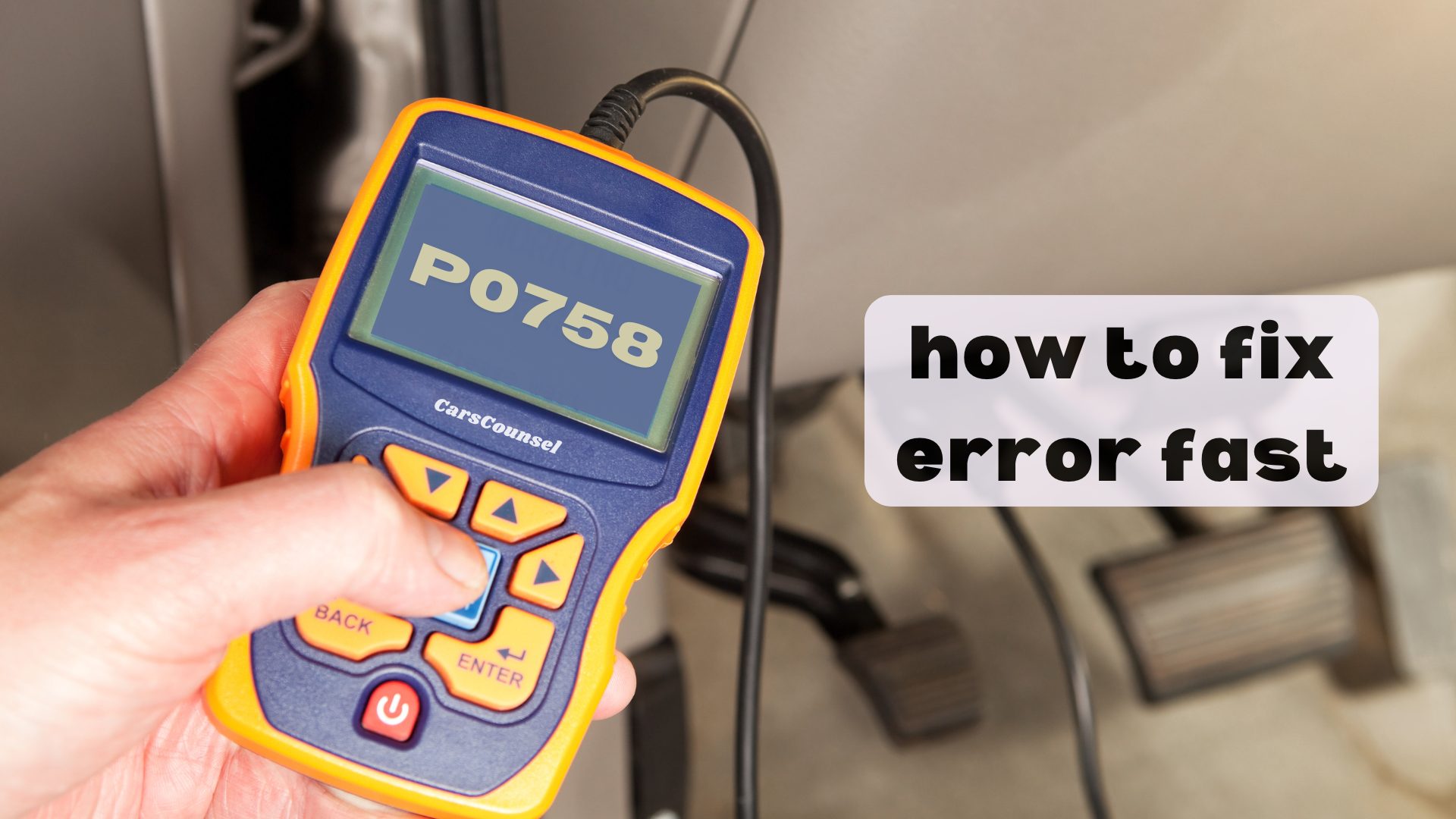Dealing with the P0758 code can be a pain, but fixing it doesn’t have to be too hard.
First, use an OBD-II scanner to confirm the error code, which points to a problem with shift solenoid B.
Next, check your transmission fluid levels and quality; this simple check can often unveil hidden issues.
You should also do resistance tests on the solenoid itself.
If the solenoid is faulty, you’ll need to replace it, which involves draining the fluid and removing the transmission pan.
Want to know the detailed steps and how to prevent this issue in the future? Let’s dig deeper.

Quick Navigation
Key Takeaways
- Use an OBD-II scanner to confirm the P0758 code and find any related problems.
- Check the transmission fluid level and condition; replace it if it’s dirty or low.
- Test the resistance on shift solenoid B to find any electrical issues.
- Look for and fix any damaged wiring or connectors in the solenoid circuit.
Understanding the P0758 Code
The P0758 code is a common issue that points to a problem with the shift solenoid B in your car’s transmission. This solenoid is crucial for managing the pressure needed for smooth gear changes.
When it fails, it can mess up the hydraulic pressure, leading to poor transmission fluid flow. As a result, you might notice your car shifts gears roughly or even slips out of gear.
The shift solenoid’s job is to ensure the transmission pressure is just right for smooth operation. If the electrical circuit for this solenoid breaks down, it can seriously hurt your car’s performance and even cause major transmission damage.
Knowing this is important for diagnosing and fixing the problem. Regular maintenance and timely inspections can help prevent these issues and keep your transmission in good shape.
Causes of the P0758 Code
Figuring out what causes the P0758 code is crucial for fixing the problem.
Often, the issue is a bad shift solenoid B valve, which can wear out, get clogged, or have electrical problems.
Transmission troubles can also come from low or dirty transmission fluid, which messes with the hydraulic pressure needed for the solenoid.
Damaged wiring or connectors can also stop shift solenoid B from working right.
Problems inside the transmission, like busted clutch packs, can affect the solenoid, too.
Plus, extreme temperatures can hurt electrical parts and mess up fluid quality.
Knowing these causes helps you diagnose and fix the P0758 code more accurately and quickly.
Symptoms of the P0758 Code
If your car has a P0758 code, you might notice delays when you speed up or slow down, indicating a transmission issue that needs quick attention.
Common signs include delays in shifting and rough gear changes, often due to a problem with shift solenoid B. Your car might also slip out of gear unexpectedly, affecting how it drives.
You could have trouble shifting into second or fourth gear, making driving more difficult. It’s important to spot these signs early and act fast to avoid bigger transmission problems and expensive repairs.
Addressing these issues quickly is crucial for keeping your car reliable.
Using an OBD-II Scanner
Using an OBD-II scanner helps you quickly read and understand the P0758 code, giving you key information to fix transmission problems.
The benefits of using an OBD-II scanner include quickly finding fault codes and getting insights into how your car is performing. This tool makes diagnosing issues easier, saving you time and effort.
However, the scanner has its limits; it only gives you error codes and basic information, which mightn’t show the real cause of the problem. For instance, it can’t detect mechanical issues or check the quality of your car’s fluids.
Checking Transmission Fluid
After you’ve read the P0758 code with an OBD-II scanner, the next step is to check the transmission fluid to make sure it’s at the right level and not dirty. This check is important to keep your transmission in good shape.
Here’s what to do:
- Find the transmission dipstick and make sure your car is on a flat surface.
- Look at the fluid:
- Level: It should be within the marked range on the dipstick.
- Color: The fluid should be clear red. If it’s dark or dirty, it’s contaminated.
Performing Resistance Tests
To perform resistance tests, first disconnect the electrical connector from shift solenoid B.
Then, use a multimeter set to the Ohms (Ω) setting to measure the resistance across the solenoid terminals.
Check your vehicle’s service manual to find out the correct resistance range for shift solenoid B.
If your reading is outside this range, the solenoid might be faulty.
Make sure all connections are clean and secure before testing.
If needed, repeat the test to ensure consistent readings, which will help in accurate troubleshooting.
Conducting Hydraulic Pressure Tests
After checking the solenoid’s electrical function, the next step is to measure the hydraulic pressure in the transmission system. This is crucial for finding any pressure problems that might affect shift solenoid B.
Here’s how to do it:
- Set Up the Gauge: Attach a hydraulic pressure gauge to the test port on your transmission.
- Check the Readings: Start the engine and look at the pressure readings at different RPMs and gear positions.
These steps will help you find pressure issues in your transmission system, ensuring an accurate diagnosis.
Good hydraulic diagnostics can prevent further problems and expensive repairs.
Repairing Shift Solenoid B
Fixing shift solenoid B starts with taking off the transmission pan to reach and replace the faulty solenoid.
Begin by draining the transmission fluid and removing the pan to expose the solenoid assembly.
Disconnect the electrical connectors and remove the solenoid’s mounting bolts.
Replace the faulty solenoid with a new one, making sure to tighten the bolts properly.
Reconnect the electrical connectors, checking for any signs of corrosion or damage.
If needed, inspect and fix any damaged wires or connectors in the shift solenoid circuit.
Preventive Maintenance Tips
Why is preventive maintenance crucial for preventing the P0758 code and ensuring your transmission lasts a long time?
Good preventive maintenance lowers the chances of problems with your transmission’s shift solenoid B and helps it last longer. Keeping up with regular maintenance can stop expensive repairs and ensure your vehicle runs smoothly.
Here are some key preventive steps:
- Fluid Maintenance: Regularly check and change your transmission fluid to keep it clean and at the right thickness.
- Routine Inspections: Regularly inspect your transmission system to catch and fix issues early.
Driving Concerns With P0758
Driving with a P0758 code can seriously damage your transmission, as it means there’s a problem with shift solenoid B. If you ignore it, your transmission may not work properly, causing issues like delayed gear shifts, rough shifting, and gears slipping unexpectedly.
This can make driving unpredictable and unsafe. Continuing to drive with this issue can lead to expensive repairs or even total transmission failure. Not fixing this problem right away can make your car less reliable and more dangerous to drive.
To keep your transmission in good shape and ensure a smooth and safe drive, get this issue checked and repaired as soon as possible.
More OBD-II Codes
Frequently Asked Questions
Can Aftermarket Solenoids Be Used for Replacing Shift Solenoid B?
You can use aftermarket solenoids to replace shift solenoid B. Just make sure they are compatible with your vehicle’s specs to keep everything working well. Check their quality and reliability to avoid future transmission problems and ensure smooth operation.
How Much Does It Typically Cost to Repair the P0758 Code?
Fixing the P0758 code usually costs between $200 and $500, not counting the cost of diagnosing the issue. If the transmission needs a lot of work or has to be replaced, you’ll pay more. Don’t forget to add in the cost of labor and parts to get a clear idea of the total expense.
Is It Possible to DIY Fix the P0758 Code Without Professional Tools?
Trying to fix a P0758 code on your own without professional tools is like navigating a storm without a map. It’s doable, but you can easily make mistakes. Make sure to carefully check the wiring, fluid levels, and solenoids to avoid making things worse.
How Long Does It Take to Replace Shift Solenoid B?
Replacing the shift solenoid usually takes about 2-4 hours. How long it takes depends on your car model and how much experience you have with repairs. Make sure you have the right tools and parts to make the process go smoothly and efficiently.
Are There Any Specific Vehicle Models More Prone to the P0758 Code?
Some vehicle brands, like Honda and Toyota, are more likely to have the P0758 code. You might see problems like delayed shifting, rough gear changes, or slipping gears. Regular check-ups can help reduce these issues.
Conclusion
In short, fixing the P0758 code is like solving a car mystery.
First, use an OBD-II scanner to confirm the error.
Then, check your transmission fluid and test the shift solenoid B with a multimeter.
Replace the solenoid if necessary.
Remember, regular maintenance can help prevent future problems.
By following these steps, you’ll keep your transmission running smoothly.

